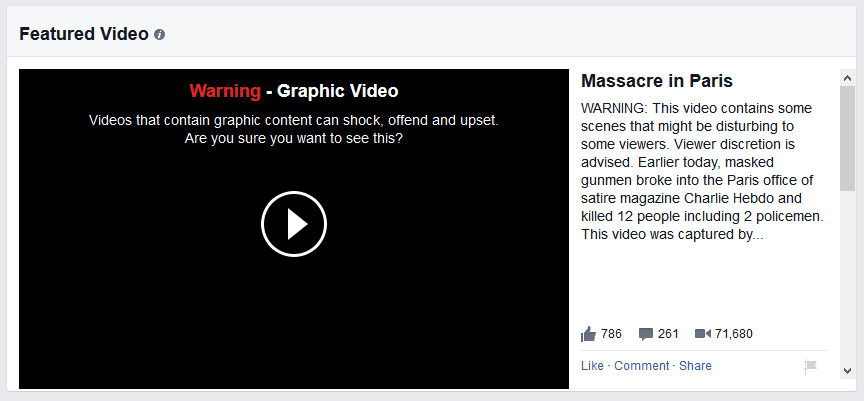
Facebook has long received complaints because they seldom remove videos when people complain about the graphic content, particularly around the sharing of news videos of ISIS beheadings and other murder videos. However, because they are deemed news content, they are rarely removed.
There is also the problem of auto-play. Many users don’t appreciate these types of videos auto-playing without warning when viewing the Facebook news feed.
The new change began in December, however many noticed it for the first time when people began sharing footage from the Charlie Hebda shooting of the police officer. Facebook will now show the graphic video warning and require users to click before the video will play. They will also disable auto-play for these videos.
For those Facebook users under 18, Facebook will no longer allow those users to view any videos with the graphic content warning.
Facebook told the BBC that the warning will be enabled on videos when they receive reports of graphic content.
“When people share things on Facebook, we expect that they will share it responsibly, including choosing who will see that content,” a spokeswoman told the BBC.
“We also ask that people warn their audience about what they are about to see if it includes graphic violence.
“In instances when people report graphic content to us that should include warnings or is not appropriate for people under the age of 18, we may add a warning for adults and prevent young people from viewing the content.”
Facebook is also looking into improving the warnings, as well as the possibility of adding it to YouTube videos that are shared on Facebook, rather than just those videos that are uploaded directly to Facebook.
It is unclear just how “graphic” a video will need to be in order to trigger the warning. Since it seems to be automated based on reports, there could definitely be some issues where videos are reported for other reasons, such as political or religious reasons, and it could technically prompt the warning to be displayed too.
If you share content that could be deemed “graphic” – or simply controversial – you may want to keep an eye on your video uploads to Facebook to ensure that the warnings aren’t being displayed in error.
Jennifer Slegg
Latest posts by Jennifer Slegg (see all)
- 2022 Update for Google Quality Rater Guidelines – Big YMYL Updates - August 1, 2022
- Google Quality Rater Guidelines: The Low Quality 2021 Update - October 19, 2021
- Rethinking Affiliate Sites With Google’s Product Review Update - April 23, 2021
- New Google Quality Rater Guidelines, Update Adds Emphasis on Needs Met - October 16, 2020
- Google Updates Experiment Statistics for Quality Raters - October 6, 2020


